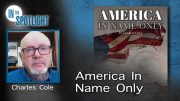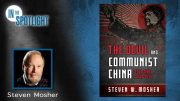
Lynn Moses, of Idaho, was incarcerated in prison on August 6, 2008, for violating the EPA’s Clean Water Act. He was found guilty of “discharging” “pollutants” into one of the “waters of the United States” and “pollut(ing) a spawning area for Yellowstone Cutthroat trout.” He is scheduled to spend 18 months in prison.
Did Moses dump fuel oil or pesticides into a trout stream to earn such a harsh sentence? Nope. He removed gravel and debris from a dry streambed — something, by the way, that he was mandated to do! You see, Moses built a subdivision by Teton Creek, a creek that because of irrigation diversions holds water less than two months of the year. To get a building permit, his county required him to modify the stream bed by removing gravel bars and downed trees to prevent future flooding of the proposed subdivision. The Army Corps of Engineers came to a planning meeting for the subdivision, but didn’t stay because they said they had no jurisdiction over “intermittent” streams.
Then he was charged with violating the Clean Water Act and was found guilty because the activist judge wouldn’t let the jury consider any information about the original agreement of the subdivision or any interaction that Moses had with federal officials that validated his position. (See the article “Feds to Imprison Idaho Man for Protecting Homes From Flooding,” online at thenewamerican.com for a more detailed story.)
In Moses’ case, the EPA, an organization that Congress had no constitutional authority to create, applied the law in an arbitrary, capricious, and vindictive manner against a U.S. citizen who was doing his utmost to follow the law, and it worked hand in hand with a federal judge in what could only be called a travesty of justice. Imagine if such abuses became commonplace; imagine that it was you or a family member who was going to prison, leaving, like Moses, who is a single parent, your 17-year-old daughter with friends.
The Founding Fathers of this country designed the Constitution and the Bill of Rights specifically to forestall just such an abuse of federal power by strictly limiting federal authority and by retaining the ultimate instruments of popular self-government — militia. Such is the historical lesson at the heart of Stephen P. Halbrook’s book The Founders’ Second Amendment: Origins of the Right to Bear Arms.
The book is a study of the period from 1768 to 1826, as it says on the book’s flyleaf, “from the last years of British rule and the American Revolution through the adoption of the Constitution and the Bill of Rights, and the passing of the Founders’ generation.” It not only uses the words and actions of the “Founders’ generation” to show why the Second Amendment came about, but to explain the meaning of the amendment and to make clear to whom the amendment applies and the level of importance the Founders attached to this “right.”
The book opens with one of the few assertions that Halbrook makes that rests largely on opinion: the widely accepted and now-famous cause for the Revolutionary War — taxation without representation — was probably not really the cause of the war. He contends that prior to the war period the colonies had made peace with England over unpopular tax-and-trade policies and would have again after this time of dissent against such taxes as the “Revenue Act, which imposed customs duties on imported glass, lead, paints, paper, and tea.” But British General Thomas Gage, with blessings from England, sent British troops to Boston and then committed the unpardonable act in the eyes of the colonists: attempting to disarm the populace. This action, according to Halbrook, led the populace to war.
Such an assertion is arguable on its face, and it would likely be contended by a range of scholars, including constitutional law expert Edwin Vieira, who wrote a book about the history of the militia before, during, and after this time period entitled Constitutional “Homeland Security”: The Nation in Arms. Vieira told THE NEW AMERICAN about Halbrook’s claim, “In fact, what Gage attempted in the way of ‘gun control’ in 1774 and 1775 was only the ‘last straw.’ More of a truly precipitating event was the Gaspee Affair in 1772.” In the Gaspee Affair, England aimed to arrest and bring to trial in England colonists believed to have boarded and then burned a British customs ship that had run aground off Rhode Island. This greatly alarmed the colonists. To Halbrook’s credit, he doesn’t label the British attempt to disarm the populace as the only reason for war, just the main reason.
As proof, Halbrook covers several years of give and take between the British and the colonists, while additionally building his central case — that the Second Amendment means that citizens are to be able to retain and carry firearms for all legal uses and that the “right to keep and bear arms” is an individual right, one that the federal government cannot “infringe” on in any way. In fact, until 1903, the Militia Act, signed by President George Washington, required that white males 18 to 45 years old provide themselves “with a good musket or firelock, a sufficient bayonet and belt, two spare flints, and a knapsack.” The Constitution so restrains the government that it cannot even add red tape to the process of getting a firearm because this would make firearm ownership more onerous and be an infringement.
He marshals prodigious evidence from during that period, including documents from when the colonies created charters for self-government during the war, such as declarations of rights that defended citizens’ rights to own, carry, and use arms. And then he carries through with documents from the debates during the drafting of the Constitution, documents from state ratifying conventions and personal correspondence by participants in the aforementioned, and articles in newspapers. He also gives the same treatment to the Bill of Rights.
His research is so thoroughly done that one can say with a certainty that anyone who says that the Second Amendment doesn’t protect an individual’s right to firearm ownership, or says that the federal government may restrict this right, may justifiably be called either ignorant or a liar. In fact, the depth of Halbrook’s research is both his greatest asset and his greatest flaw. As the book moves forward, there are so many similar sentiments about the Second Amendment backing an “individual right” perspective that occasionally the sheer redundancy makes one’s interest drag.
The evidence proves that there is absolutely no question that the Second Amendment means that the federal government may not make any rules restricting firearms ownership. What is less clear to readers is to what extent, if any, that states may restrict firearms ownership.
For instance, on the side of those who argue that the state may put restrictions on gun ownership, one could point to the fact that the Federalists (those people who were for passing the Constitution without a bill of rights) pointed out repeatedly that no bill of rights was needed because any power not positively given by the Constitution to the federal government fell under the auspices of the states. This is further reinforced by the Federalists’ oft-repeated argument that any rights and powers that might be listed in a bill of rights as belonging to the people or the states would merely be a tiny subset of all the rights and powers that they actually held. So, because the Constitution does not forbid the states from enacting gun-control measures, it retains that power. In a similar vein, as Halbrook shows, the First Amendment forbids Congress from making any laws establishing or forbidding religion, but several states at the time that the Constitution was ratified had state-sponsored religions.
Also backing this view is the fact that several states had as part of their state measures laws that would restrict firearm ownership to those who were free men and that would disarm those who posed a “real danger of public injury.”
The main argument in opposition to those views is that the Bill of Rights listed both state powers and some personal inalienable “rights.” In the Constitution the word “rights” is only associated with individual freedoms, not state rights. By ratifying the Bill of Rights, then, state laws restricting gun ownership would be null and void. (The laws against slaves owning firearms wouldn’t be applicable because slaves were considered property, not people.) As Halbrook puts it, “It would not make sense to say that ‘the people have a right’ to do something only if the state authorizes it.”
But all the preceding arguments about state powers ignore the historical context in which the Second Amendment was derived. As Vieira states: “Whether the other parts of the Bill of Rights applies to the States, the Second Amendment surely does, because: The Militia are (as the original body of the Constitution makes clear) ‘the Militia of the several States’; the key principle of all the pre-constitutional Militia throughout the Colonies and independent States for about 150 years was that every able-bodied free man was required to possess his own firearm in his own home at all times; the Constitution presumes that the Militia will continue in existence just as they were in the late 1700s; the Constitution even orders Congress ‘to provide for organizing, arming, and disciplining the Militia’ — so that no government at any level, may disarm the Militia. Essentially all ‘gun control’ of the modern variety is unconstitutional.”
Though Halbrook’s material doesn’t definitively answer the question about state powers over firearms, the book is an excellent resource for anyone who wants to form a knowledgeable opinion on the meaning, application, and reason behind the Second Amendment.



